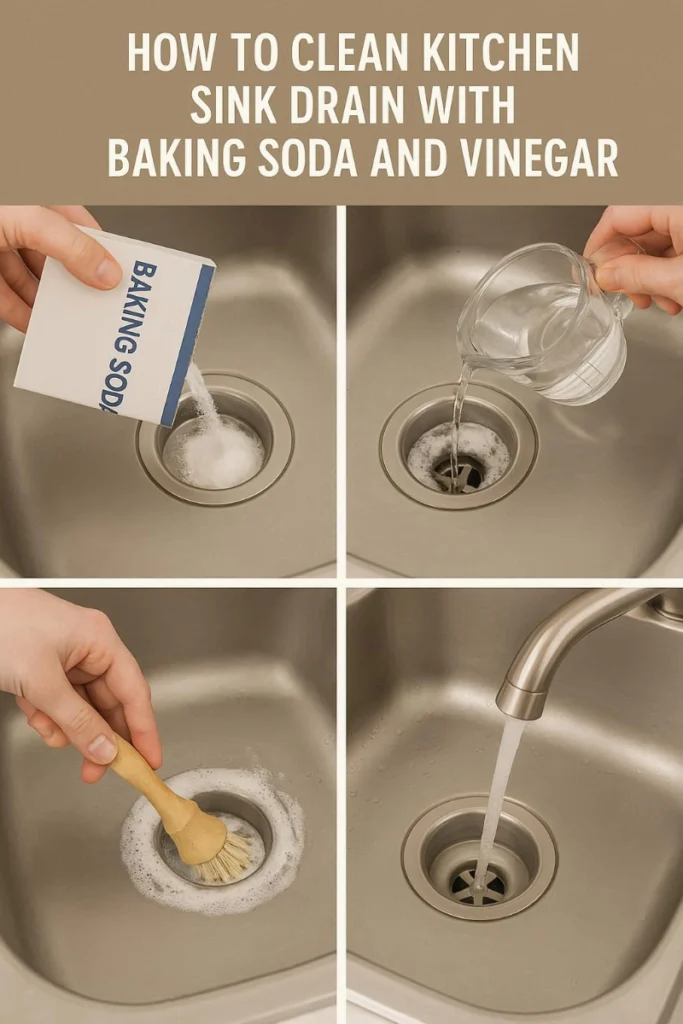We’ve all experienced it—the stubborn odor coming from the kitchen sink or the slow-draining water that seems to refuse to disappear. These are common issues that many homeowners face with their kitchen sinks. While store-bought chemical drain cleaners may seem like an easy fix, they come with their own set of risks: toxic chemicals, strong fumes, and potential harm to your pipes and the environment.
Luckily, there’s a safe, eco-friendly, and effective alternative—baking soda and vinegar! These two household staples work together to clean your kitchen sink drain naturally, eliminating clogs and odors while keeping your plumbing in good condition. In this guide, we’ll walk you through the step-by-step process of using baking soda and vinegar to clean your kitchen sink drain, as well as some troubleshooting and preventative tips to keep your drain clean long-term.
Benefits of Using Baking Soda and Vinegar for Drain Cleaning
When it comes to cleaning kitchen sink drains, baking soda and vinegar offer a range of benefits that chemical solutions simply can’t match. Here’s why this natural method is the best Cleaning Guide for Home & Kitchen choice for your sink.
A Safe, Chemical-Free Solution
In today’s world, we’re all trying to minimize our exposure to harsh chemicals, especially in the kitchen where we prepare our food. Baking soda and vinegar are both non-toxic and safe for use in the home. These ingredients don’t contain any harmful chemicals that could potentially damage your pipes or pollute the water supply.
- Environmentally Friendly: Baking soda and vinegar are biodegradable, which means they won’t harm the environment when washed down the drain.
- Safe for Septic Systems: If you have a septic system, using natural cleaning methods like this one is crucial to maintaining a healthy system.
Eliminates Odors Naturally
The kitchen sink is a hot spot for lingering smells. Leftover food particles, grease, and organic waste can cause your drain to emit foul odors. Baking soda neutralizes odors, while vinegar helps to break down food particles and bacteria. Together, they leave your sink smelling fresh and clean.
Prevents Clogs and Improves Drainage
One of the most frustrating things about a kitchen sink is dealing with clogged or slow-moving water. Over time, grease, soap scum, and food debris can build up in your pipes, causing blockages. The fizzy chemical reaction between baking soda and vinegar helps to break down these build-ups, preventing clogs and improving drainage. The best part? It’s completely natural and won’t damage your pipes.
Tools and Ingredients You’ll Need
Before you start cleaning, make sure you have the right tools and ingredients on hand. Here’s everything you’ll need:
Baking Soda
Baking soda is a powerhouse cleaner. It works by lifting dirt, grease, and odors, and is a great deodorizer. It’s safe, gentle, and doesn’t scratch or damage surfaces.
- How Much to Use: About 1/2 cup of baking soda is typically enough for cleaning your kitchen sink drain.
Vinegar (White or Apple Cider)
Vinegar is acidic, making it effective in breaking down mineral deposits, soap scum, and grease in your pipes. Both white vinegar and apple cider vinegar work well, but white vinegar is the most common and affordable option.
- Choosing Between White Vinegar or Apple Cider Vinegar: White vinegar is a better choice for cleaning drains because it has a higher acidity and fewer impurities. Apple cider vinegar can be used, but it may leave a slight scent behind.
Hot Water
Hot water helps dissolve and wash away the loosened debris after the baking soda and vinegar have done their magic. It’s important to use hot (but not boiling) water to avoid damaging your pipes.
Optional Tools
- Sink Plunger: For tougher clogs, a sink plunger can help dislodge any remaining debris.
- Cleaning Cloth or Rag: For wiping down any mess.
- Pipe Brush: If you have a more severe clog, a pipe brush can help scrub out stubborn buildup from inside your pipes.
Step-by-Step Guide to Cleaning Your Kitchen Sink Drain with Baking Soda and Vinegar
Now that you have your supplies ready, it’s time to get started. Here’s a step-by-step guide to clean your kitchen sink drain using baking soda and vinegar.
Step 1: Clear the Sink Area
Before you begin, make sure the sink is empty of dishes and any other debris. The cleaner the sink area, the better the results.
- Why It’s Important: A clean workspace allows you to focus on the drain without any distractions, and ensures that the cleaning solution can work effectively.
Step 2: Pour Baking Soda into the Drain
Measure out about 1/2 cup of baking soda and pour it directly into the drain. You want to ensure that the entire drain opening is covered.
- Why This Matters: Coating the drain helps to tackle any grime, grease, or debris that may be lingering. Baking soda works to break down build-ups and neutralize odors.
Step 3: Add Vinegar to the Drain
Next, pour about 1 cup of vinegar (white or apple cider) into the drain. You’ll notice a fizzy, bubbly reaction as the two ingredients react. This fizzing action helps break apart grease, soap scum, and food particles stuck in the drain.
- How It Works: The chemical reaction between baking soda and vinegar lifts out grease and debris, making it easier to clear the drain and restore proper flow.
Step 4: Cover the Drain and Let It Sit
After adding the vinegar, immediately cover the drain with a sink stopper or rag to trap the fizzing action inside. Let it sit for about 10 to 15 minutes.
- Why This Is Important: Allowing the mixture to sit lets the solution penetrate the pipes and break down any stubborn debris. It’s important not to rush this step.
Step 5: Rinse with Hot Water
Finally, boil some water and slowly pour it down the drain. The hot water will help rinse away the loosened grime and ensure your pipes are clear.
- Why It’s Crucial: Thoroughly rinsing with hot water clears away any remaining debris and prevents residue from building up again.
Troubleshooting: What to Do If Your Drain Is Still Clogged
Even with the best cleaning efforts, some clogs may require a little extra help. Here are a few tips if your drain is still slow or clogged.
Using a Sink Plunger
If your drain is still clogged after cleaning, a sink plunger can help dislodge the debris.
- How to Use: Position the plunger over the drain and push down forcefully, then pull up sharply. Repeat this action a few times to loosen the clog.
Using a Pipe Brush
For deeper clogs or build-ups inside the pipes, a pipe brush can help clean out the gunk. Carefully insert the brush into the drain and gently scrub the pipes.
- When to Call a Plumber: If you’re still having trouble after trying the plunger and pipe brush, it may be time to call in a professional plumber to inspect your pipes.
Preventative Tips to Keep Your Sink Drain Clean
Regular maintenance is key to preventing future clogs and odors. Here are some tips to keep your drain in tip-top shape:
Regular Maintenance
To prevent buildup in your kitchen sink drain, clean it with baking soda and vinegar once a month. This regular maintenance will help keep your pipes clear and your sink smelling fresh.
Avoid Pouring Grease or Coffee Grounds Down the Drain
Grease and coffee grounds can easily cause clogs over time. Instead, dispose of them in the trash to keep your pipes clear.
Use a Drain Strainer
A drain strainer will catch larger food particles and prevent them from entering the drain. This simple tool can save you from a lot of hassle and keep your sink clear of debris.
Conclusion
Cleaning your kitchen sink drain with baking soda and vinegar is a quick, effective, and natural solution to keep your sink fresh and free from clogs. By following the simple steps in this guide, you can tackle odors and blockages without relying on harmful chemicals. Regular maintenance will ensure your pipes stay clear and your kitchen sink remains in great shape.
FAQ
How often should I clean my kitchen sink drain with baking soda and vinegar?
For optimal results, clean your drain once a month, or more often if you notice odors or slow drainage.
Can I use this method for bathroom sinks or tubs?
Yes, this method works for other drains around the house, including bathroom sinks and tubs. The process is the same!
Will this method work on really stubborn clogs?
Baking soda and vinegar are great for mild to moderate clogs, but for severe blockages, you may need to use a plunger or call a plumber.
Is vinegar safe for all types of pipes?
Yes, vinegar is safe for most types of pipes, including PVC, copper, and galvanized steel. It’s gentle on your plumbing and won’t cause damage.
What should I do if the sink still smells after using baking soda and vinegar?
If odors persist, try using lemon juice or check the P-trap to ensure it’s not clogged.
Call to Action
Ready to give this natural cleaning solution a try? Grab your baking soda and vinegar, and tackle that kitchen sink drain today! Let us know how it works for you, or share your experience with us in the comments below.

